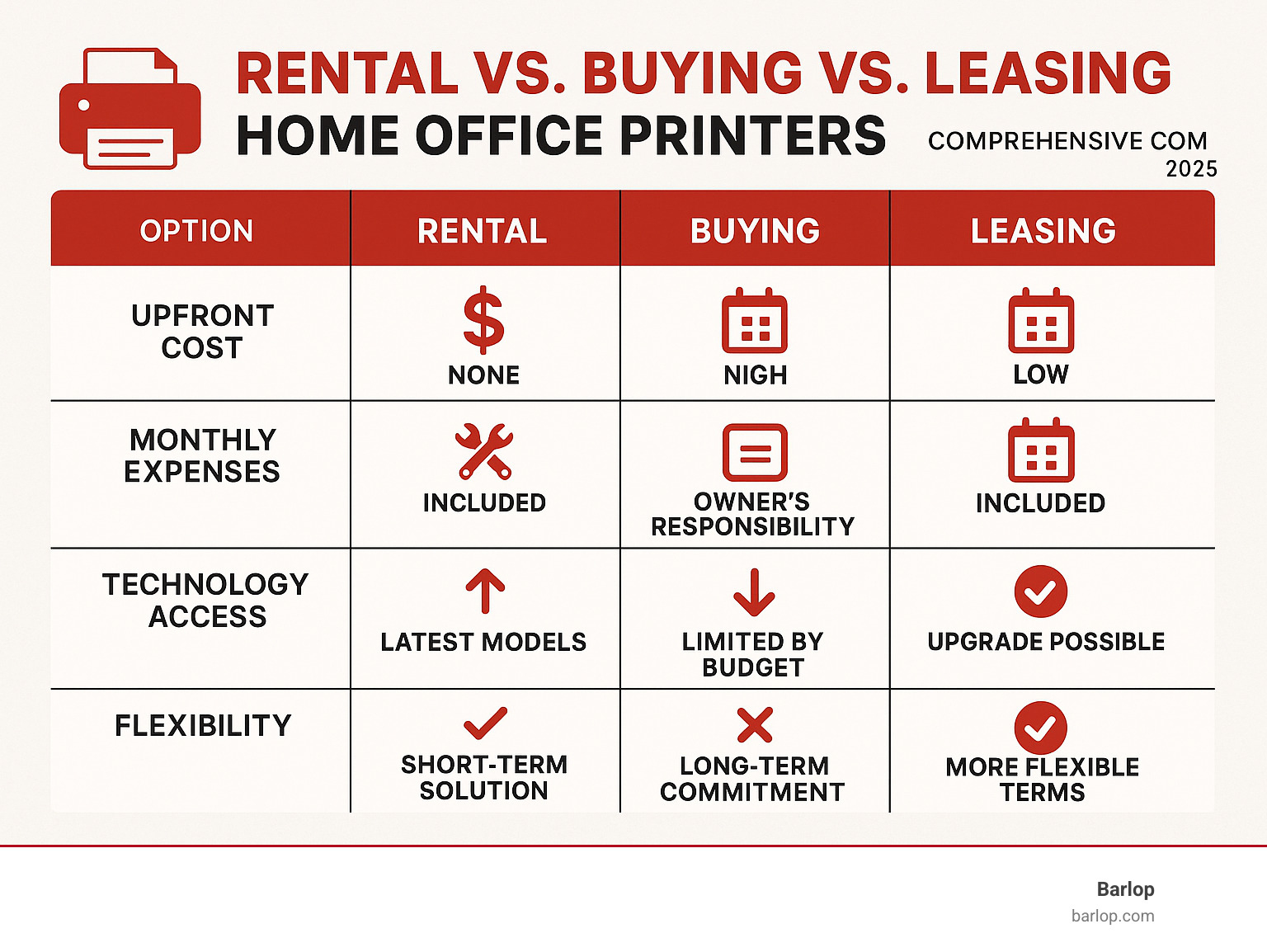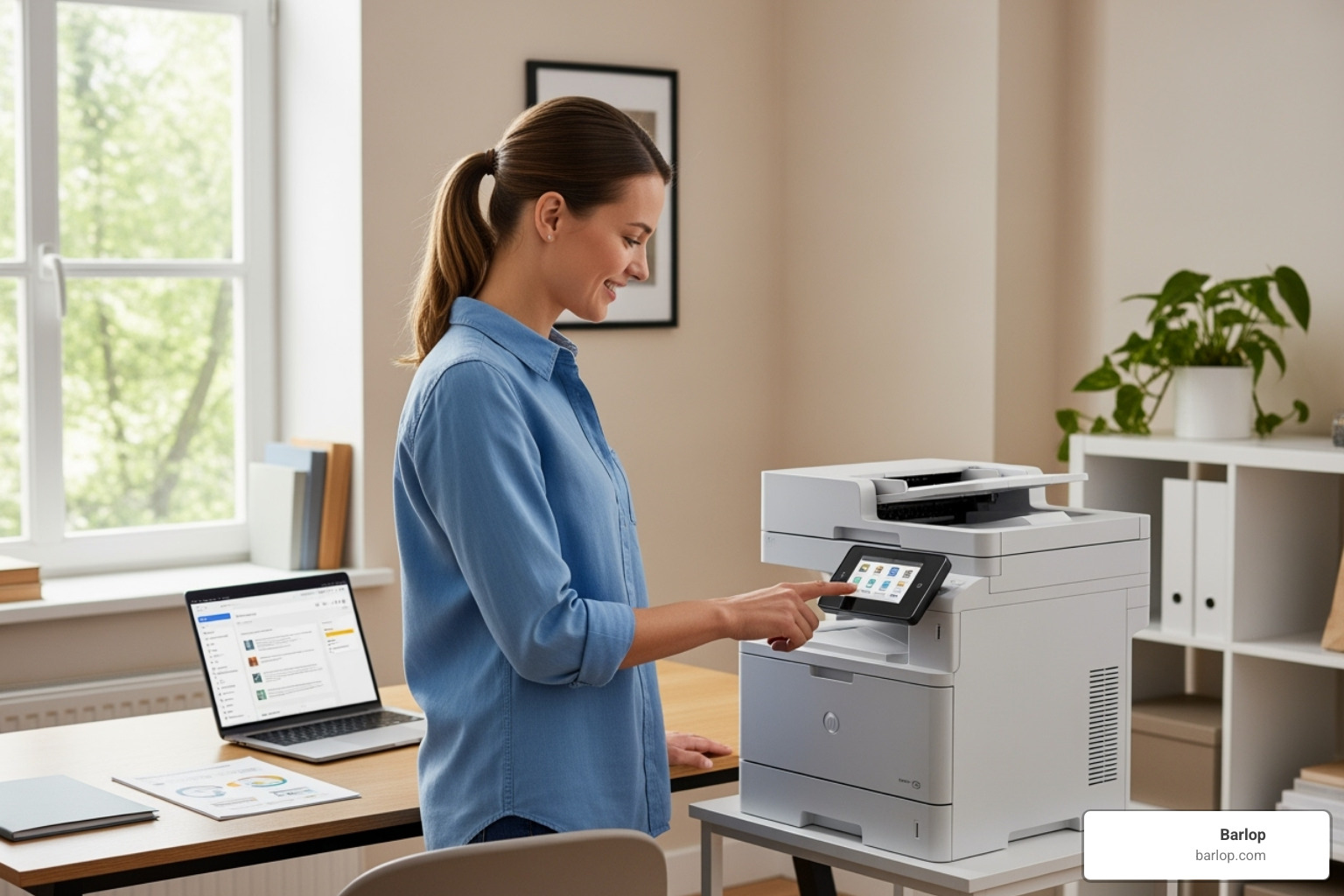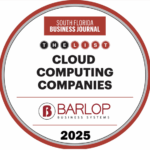Rent a printer for home office setups has become a surprisingly smart solution for many remote workers. Here’s what you need to know:
Quick Answer: Should You Rent?
- YES if you need: Predictable monthly costs, maintenance-free operation, access to high-end equipment, or short-term solutions
- NO if you have: Very light printing needs (under 100 pages/month), prefer ownership, or print only occasionally
- MAYBE if you: Want to test different printer types, need seasonal flexibility, or are tired of managing ink costs
The shift to remote work has transformed millions of homes into productivity hubs. But here’s what most people don’t realize: that cheap inkjet printer from the big box store might be costing you more than a commercial-grade rental.
Roger Horncastle from The UPS Store put it perfectly when describing his experience with rental equipment: the service was “flawless” with “24-hour service support” available when needed. That’s the kind of reliability home offices need but rarely get from consumer printers.
The reality is stark: Home office workers often face the same printing demands as small businesses but with consumer-grade equipment that breaks down, runs out of ink at the worst moments, and lacks the features needed for professional work.
Printer rental flips this equation. Instead of owning a depreciating asset that you have to maintain, you get access to professional equipment with predictable costs and zero-hassle support.

Rent a printer for home office definitions:
The Allure of Renting: Key Benefits for the Modern Home Office
Picture this: you’re deep into an important project when your home printer decides to stage a rebellion. The ink runs dry mid-document, or worse, that dreaded paper jam error flashes just when you need it most. Sound familiar? This is exactly why more professionals are choosing to rent a printer for home office setups instead of dealing with the headaches of ownership.
The shift from owning to renting represents something bigger than just getting a machine – it’s about changing your home office into a truly professional workspace without the traditional hassles. When your dining table doubles as a conference room and your spare bedroom is mission control, you need equipment that simply works.
Cost predictability stands out as the biggest game-changer. Remember the last time you bought replacement ink cartridges and nearly fell over at the checkout? Those surprise expenses can easily run into hundreds of dollars, often costing more than the original printer. When you rent a printer for home office use, you get a fixed monthly fee that covers everything. No more budgeting surprises or emergency runs to the office supply store.
Maintenance-free operation means you can finally say goodbye to becoming an amateur printer technician. Rental agreements typically include comprehensive support – if something breaks, it’s not your problem to solve. You won’t spend your Saturday morning watching YouTube videos about fixing paper feed mechanisms or deciphering cryptic error codes.
The access to superior technology aspect is where things get really interesting. Those consumer-grade printers from big box stores? They’re designed for light home use, not the demands of a professional workspace. Rental options give you access to commercial-grade multifunction printers that can handle heavy workloads, produce sharper documents, and offer features like high-speed scanning and advanced connectivity. You’re essentially getting enterprise-level equipment without the enterprise-level price tag. This is exactly why it’s time to Stop Overpaying for Print: Why It’s Time to Upgrade from Low-Cost Store-Bought Printers to Commercial-Grade Equipment.
Flexibility for changing needs adapts to how we actually work today. Maybe you’re handling a major client project that requires tons of printing for three months, then things quiet down. Or perhaps you’re testing out remote work before making it permanent. Rental contracts can be as short as a few days or as long as several years, adjusting to your real-world demands rather than forcing you into a one-size-fits-all solution.
When Renting Makes Perfect Sense

While renting offers broad advantages, certain situations make it an absolute no-brainer. If you find yourself nodding along to any of these scenarios, you’re probably looking at a perfect rental candidate.
Project-based work creates unique printing demands that ownership can’t efficiently address. Think about legal professionals preparing for a big case, researchers compiling extensive documentation, or consultants putting together comprehensive proposals. These situations require reliable, high-volume printing for a defined period, making short-term rentals ideal.
Seasonal peaks hit many professionals hard, especially during tax season, year-end reporting, or annual compliance periods. Rather than overworking a basic home printer or making countless trips to print shops, a temporary commercial-grade rental handles the surge professionally and efficiently.
Startups and freelancers face the classic cash flow challenge – every dollar needs to work hard, and tying up capital in depreciating equipment rarely makes sense. Renting preserves working capital while providing access to professional-grade equipment that would otherwise be financially out of reach.
Temporary remote work setups became incredibly relevant during recent global shifts, and many companies finded the value of flexible solutions. Whether you’re on a short-term assignment, testing remote work arrangements, or adapting to unexpected circumstances, renting provides immediate professional capability without long-term commitments. This approach proved so valuable that services like Barlop Offering Short-Term Rentals and Upgrade Plans for Remote Locations During COVID-19 Epidemic became essential business solutions.
What’s Included in a Typical Rental Plan?
The beauty of modern printer rental lies in how comprehensive these packages have become. You’re not just getting a machine – you’re getting a complete printing solution designed to eliminate every traditional headache.
All-inclusive programs bundle everything into one predictable monthly payment. The printer, all consumables, maintenance, and support typically fall under a single fee structure. This approach transforms printing from a variable expense with surprise costs into a fixed operational expense you can budget around confidently.
Automatic ink and toner delivery solves one of the most frustrating aspects of printer ownership. Advanced rental units monitor their own supply levels and automatically order replacements before you run out. No more finding empty cartridges at the worst possible moment or making emergency supply runs.
On-site maintenance and repairs mean technical issues become someone else’s responsibility. Whether it’s routine maintenance, troubleshooting, or major repairs, qualified technicians handle everything. Your job is to print; their job is to keep everything running smoothly.
24/7 customer support recognizes that home office professionals often work outside traditional business hours. When problems arise at 9 PM on a Sunday before a Monday deadline, having access to expert help can be the difference between meeting commitments and scrambling for alternatives.
Next-business-day replacement represents the ultimate backup plan for critical situations. When repairs aren’t feasible or quick enough, premium rental agreements include rapid replacement services to minimize downtime. This level of service reliability typically requires enterprise-level contracts when purchasing equipment, but becomes standard with quality rental agreements. You can review detailed specifications about this service level in the next business day replacement data sheet.
What to Expect When You Rent a Printer for Home Office
Understanding the process from start to finish is key to a hassle-free experience when you decide to rent a printer for home office. Most rental services are designed for convenience, but it’s crucial to know what you’re signing up for. It’s not just about picking a machine; it’s about understanding the ecosystem of support and service that comes with it.
Common Printer Types Available for Rental
When we consider which type of printer to rent for a home office, the good news is that there’s a vast selection available, catering to almost any need. Unlike consumer purchases where options might be limited, rental fleets often include commercial-grade equipment.
Here are the common types you’ll encounter:
- Inkjet Printers: These are excellent for high-quality color prints, especially photos, and are often more affordable upfront. Many rental services, like Six Star Rentals, offer various Epson and HP inkjet models. They are generally quieter and can handle a wider range of paper types.
- Laser Printers: Known for their speed, precision, and cost-effectiveness for high-volume monochrome (black and white) printing. They use toner, which lasts much longer than ink cartridges, making them ideal for document-heavy home offices. Absolute Toner and Busys.ca both offer a wide range of laser printer options.
- Multifunction Printers (MFPs): These are the workhorses of any office, combining printing, scanning, copying, and often faxing capabilities into one device. They are incredibly popular for home offices because they save space and offer comprehensive functionality. Many rental companies, including Xerox and We Rent Copiers, provide a wide selection of MFPs. You can explore more about these versatile machines here: Rent Multifunction Printer.
- A4 and A3 Capabilities: Most home office printing is done on A4 (standard letter size) paper. However, if your work involves larger documents, such as blueprints, marketing materials, or presentations, you can often find rental printers capable of handling A3 (tabloid) paper sizes. Companies like Absolute Toner and Busys.ca list printers with 11×17 and 12×18 inch paper support.
- Specialty Printers: For very specific needs, some providers might offer specialty printers like large format plotters for architectural drawings or production color printers for graphic design work. While less common for typical home offices, it’s worth inquiring if your needs are unique.
Decoding the Costs and Contract Terms
Understanding the financial structure and contractual obligations is crucial before you commit to rent a printer for home office. This is where renting truly differs from buying, as the “cost of ownership” is bundled into your agreement.
- Monthly Fees: This is the most common pricing model. You pay a fixed amount each month, which covers the printer, and often supplies and service. These fees can vary widely depending on the printer model, its features, and the included services. For instance, HP All-In Plan starts at $6.99/month, while other rentals can go up to $23.61 per week (€4.99/month in Europe, as per Fair Print Solutions).
- Cost-Per-Page Models: Some rental agreements, particularly for higher-volume users, might include a base monthly fee plus a charge for each page you print (a “Cost Per Print” service program, as offered by Busys.ca). This model can be very cost-effective for businesses with fluctuating print volumes, as you only pay for what you use beyond a certain threshold.
- Contract Length (Short-Term vs. Long-Term): Rental terms are highly flexible. You can find “short-term rentals” for as little as 3 days (Xerox) for events or projects, monthly plans, or longer-term agreements of 12, 24, or 36 months (printer4you.com, Six Star Rentals). Fair Print Solutions even boasts “no minimum contract duration,” emphasizing flexibility. Your choice depends on your anticipated needs and how much commitment you’re comfortable with.
- Page Volume Limits and Overage Charges: Many plans come with a set number of pages included in the monthly fee. If you exceed this limit, you might incur “overage charges” for each additional page. It’s vital to accurately estimate your printing volume to avoid unexpected costs. HP All-In Plan, for example, details how overage charges are applied.
- Cancellation Policies and Fees: If you need to end your rental agreement early, be aware of the cancellation policy. Some plans, especially subscription models, might have early termination fees. HP All-In Plan, for instance, has cancellation fees ranging from $120 to $345 for the first year, decreasing over time. However, some services like printer4you.com state that contracts end automatically without cancellation, and the printer becomes yours. Always read the fine print!
Understanding these elements helps us evaluate the true cost of printing, as discussed in How Much Does a Printer Really Cost?.
Renting vs. Buying: A Head-to-Head Comparison
This is the central question for any home office professional weighing their options. While buying offers ownership, renting provides a service-oriented solution that can be more practical and economical in certain situations.
Let’s be honest here: the decision to rent a printer for home office versus buying one isn’t really about which option is universally “better.” It’s about finding what works for your specific situation. Think of it like choosing between owning a car or using a ride-sharing service – both get you where you need to go, but the right choice depends on how often you travel, your budget, and how much you enjoy dealing with maintenance.
When you buy a printer, you’re making a capital investment. You own the hardware outright, which gives you that satisfying sense of ownership and control. But here’s the catch: all the headaches that come with ownership are yours too. The surprise ink costs, the mysterious paper jams at 11 PM, the warranty that expired just before the scanner stopped working – it all lands on your desk.
Renting flips this equation entirely. When you rent a printer for home office use, you’re essentially paying for peace of mind wrapped in a monthly service. The rental company retains ownership, but they also take on all the stress of keeping that machine running smoothly. It transforms your printer from a potential source of frustration into a predictable, reliable tool that just works.
The sweet spot often comes down to your printing habits and tolerance for printer-related drama. If you’re printing just a handful of pages each month and genuinely don’t mind troubleshooting technical issues, buying might make financial sense. But if you value your time, need reliable performance, or simply want predictable monthly expenses, renting quickly becomes the smarter choice.
The Simple Process to Rent a Printer for Home Office
One of the most refreshing aspects of modern printer rental is how straightforward the process has become. Gone are the days of complicated procurement procedures – most providers have streamlined everything to get you printing as quickly as possible.
The journey typically starts with a needs assessment. This isn’t just a sales pitch disguised as consultation – it’s genuinely helpful. A good provider will ask about your monthly page volume, whether you need color printing, and if features like scanning or faxing are essential. They might also consider your space constraints and network setup. This step is crucial because getting the wrong printer is frustrating whether you’re buying or renting. Companies like Barlop understand that a proper What is a Print Assessment? Why Should Every Business Get One? can save everyone time and money.
Getting a quote comes next, and this is where rental services really shine in terms of transparency. Unlike buying, where you might find hidden costs for extended warranties or premium ink later, rental quotes typically include everything upfront. You’ll see the monthly fee, what’s included, and any potential overage charges clearly laid out.
The delivery and installation phase is where you’ll appreciate not having to figure out network settings or driver installations yourself. Professional rental services handle the setup, ensuring your printer is connected to your home network and ready to go. They’ll often test everything before leaving, so you’re not left staring at error messages.
Ongoing support and supplies represent the true value of rental agreements. Your ink or toner is typically monitored and delivered automatically – no more emergency runs to the office supply store. Technical support is just a phone call away, and many providers offer remote troubleshooting to resolve issues quickly.
Finally, end-of-term options give you flexibility that buying simply can’t match. You might choose to upgrade to a newer model, extend your rental, or simply return the equipment. Some programs even offer a path to ownership if you decide you want to keep the printer permanently.
[TABLE] comparing Renting vs. Buying a Home Office Printer
| Feature | Renting a Printer | Buying a Printer |
|---|---|---|
| Upfront Cost | Low to none | High |
| Maintenance | Included in plan | Your responsibility |
| Supplies (Ink/Toner) | Often included/automated | Purchased separately |
| Technology | Easy to upgrade | Becomes outdated |
| Flexibility | High (short-term options) | Low (stuck with device) |
| Long-Term Cost | Can be higher over years | Lower if device lasts |
The table above tells the story at a glance, but the real-world implications run deeper. That “high upfront cost” for buying isn’t just about the initial purchase – it’s about committing to a piece of technology that might not meet your needs in six months. The “included maintenance” for rentals means you’re not googling error codes at midnight or waiting weeks for repair appointments.
Perhaps most importantly, the flexibility advantage of renting has become invaluable in our rapidly changing work environment. Your printing needs today might be completely different next year, and rental agreements can adapt in ways that ownership simply cannot.
Finding the Right Rental Partner for Your Needs
Choosing a provider is as important as deciding to rent a printer for home office. A good partner ensures your equipment is a tool, not a hindrance. Look for transparency, excellent support, and terms that fit your specific home office workflow.
The rental market has exploded in recent years, which is great news for choice but can make the selection process feel overwhelming. The key is finding a provider who views themselves as your technology partner, not just an equipment vendor.
Quality partnerships start with quality brands. Look for rental companies that work with established manufacturers known for reliability. These partnerships often mean better support, genuine parts, and access to the latest technology updates.
All-inclusive programs are often your best bet for predictable costs and comprehensive support. These bundles eliminate surprise expenses and streamline your entire printing experience. When a company offers truly all-inclusive service, it shows they’re confident in their equipment and committed to your success.
Customer testimonials and reviews tell the real story. Look beyond the marketing materials to see how the company handles real-world challenges. A provider with consistently positive feedback about their response times and problem-solving approach is worth their weight in gold.
Key Questions to Ask a Potential Provider
Before you commit to a rental agreement, arm yourself with these crucial questions. They’ll help you understand the fine print and ensure the service aligns perfectly with your home office demands.
What are the full terms of the service agreement? This goes far beyond the monthly fee. You need to understand minimum contract duration, early termination policies, and end-of-term options. Some agreements automatically transfer ownership to you, while others require equipment return.
What does your support include? The quality of support can make or break your rental experience. Ask about response times, availability hours, and whether support includes both remote troubleshooting and on-site visits when needed. Some providers guarantee response times within hours, not days.
How is ink and toner managed? True automatic supply management means the printer monitors itself and orders supplies before you run out. Confirm whether you’ll receive original manufacturer supplies or third-party alternatives, and clarify any associated costs.
What happens if my printing needs change? Your home office demands might fluctuate seasonally or as your business grows. Ask about plan flexibility, page volume adjustments, and policies for unused pages. The best providers make changes simple and penalty-free.
What is the process for returning or upgrading equipment? Understanding the logistics upfront prevents headaches later. Ask about return shipping costs, installation of replacement equipment, and upgrade pathways to newer technology.
Exploring comprehensive solutions like Managed Print Services can give you a complete picture of how a provider bundles all these elements into a seamless experience. The right partner transforms printing from a potential headache into a reliable, predictable service that simply works.
Frequently Asked Questions about Home Office Printer Rentals
When considering whether to rent a printer for home office use, you’re bound to have questions. These are the most common concerns we hear from home office professionals, and honestly, they’re all perfectly reasonable things to wonder about.
Can I rent a high-quality multifunction printer for a home office?
Absolutely! This might be one of the biggest surprises for people new to printer rentals. You’re not stuck with basic, bare-bones machines. Most rental companies maintain fleets of commercial-grade multifunction printers (MFPs) that can print, copy, scan, and fax with impressive quality and speed.
These aren’t the flimsy consumer printers you’d find at an electronics store. We’re talking about the same robust machines that power busy corporate offices. They’re built to handle heavy workloads without breaking down, offer faster print speeds, hold more paper, and deliver advanced scanning options that basic home printers simply can’t match.
For many home office professionals, this is a game-changer. You get access to technology that would cost thousands to purchase outright, all for a predictable monthly fee. It’s like having a professional print shop right in your spare bedroom.
What is the typical contract length when you rent a printer for home office?
Here’s where rental services really shine with flexibility. The contract length options are designed to fit virtually any situation you might find yourself in.
Need something ultra-short-term? You can find rentals for just a few days if you’re handling a specific project or event. Working on a month-long contract? Monthly plans are readily available. Planning ahead for the long haul? Traditional agreements typically run 12, 24, or 36 months.
Some subscription-style services offer month-to-month flexibility after an initial period, which is perfect if your needs change frequently. The beauty is that you’re not locked into a one-size-fits-all approach. Whether you’re testing out remote work, handling seasonal business peaks, or just want the freedom to adjust as your home office evolves, there’s likely a contract structure that fits.
Are printer rentals more expensive than buying in the long run?
This is probably the question we get asked most, and the honest answer is: it depends on how you use your printer.
For high-volume users who print hundreds or thousands of pages monthly, renting often comes out ahead financially. When you factor in the cost of ink cartridges (which can cost more than some printers themselves), unexpected repairs, and the eventual need to replace outdated equipment, those “savings” from buying can evaporate quickly.
Renting also eliminates those nasty surprise expenses. No more finding your printer died the night before an important deadline. No more sticker shock at the office supply store when you realize a set of color cartridges costs nearly as much as a new printer.
However, if you’re a very light user who prints fewer than 100 pages monthly and rarely needs support or advanced features, buying a basic printer might be more economical over several years. The key word there is “might” – it assumes your cheap printer won’t break down or guzzle expensive ink.
The real advantage of renting isn’t just potential cost savings, though. It’s the predictability. You know exactly what you’ll spend each month, and that peace of mind has real value when you’re managing a home office budget.
Conclusion

After diving deep into home office printing solutions, the decision to rent a printer for home office ultimately boils down to understanding your unique situation and priorities. There’s no one-size-fits-all answer, but there are clear patterns that can guide your choice.
If you’re someone who values predictable monthly costs over surprise expenses, renting makes tremendous sense. No more sticker shock when you find that replacement ink cartridges cost more than your original printer. No more weekend trips to the electronics store when your printer decides to break down right before an important deadline.
The zero-hassle maintenance aspect alone converts many home office professionals. When your printer stops working, it becomes the rental company’s problem, not yours. You get to focus on what actually matters – your work – instead of becoming an amateur printer technician.
For those whose printing needs fluctuate, the flexibility to adapt is invaluable. Maybe you’re a freelancer who occasionally takes on high-volume projects, or perhaps you’re testing the waters with a new remote work arrangement. Renting lets you scale up or down without being stuck with expensive equipment that doesn’t match your current needs.
The change is remarkable: your printer evolves from a costly asset that demands constant attention into a simple, reliable service that quietly does its job. For anyone tired of dealing with error codes, supply shortages, and unexpected repair bills, this shift represents genuine peace of mind.
Of course, renting isn’t perfect for everyone. If you print fewer than 100 pages monthly and rarely need support, a basic purchased printer might serve you better financially over many years. But for the vast majority of home office professionals – those who need reliability, professional output, and predictable costs – renting offers a compelling path forward.
Barlop understands that every home office has different needs and challenges. We’re here to help you steer these decisions and find a printing solution that actually works for your specific situation. Explore our flexible copier and printer leasing options to find the right fit for your home office.





